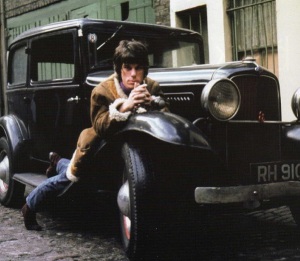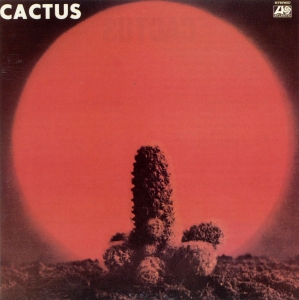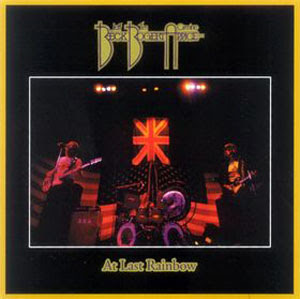In July of 1969, the Jeff Beck Group split after two successful and groundbreaking albums for CBS. Singer Rod Stewart joined bassist Ron Wood (yes, you read that right, ‘bassist’) in a revamped version of the Small Faces. Beck was immediately approached by the Rolling Stones to replace Mick Taylor, but declined the offer. Jeff Beck had other plans: a team-up with Tim Bogert and Carmine Appice, formerly the rhythm section of American psychedelic rockers Vanilla Fudge. While Beck waited for the Fudge to wrap up their touring commitments, fate intervened… in the form of a car accident.
It’s well known that iconic guitarist Jeff Beck’s other great passion is for American hot rods; The guitarist has amassed a collection of over 30, and has built or modified many of them himself over the course of his almost 50-year career. Beck also has a history of car wrecks (3), and was once sidelined for several months after crushing his thumb under a car he was restoring. Maybe not the best hobby for one of the Greatest Guitarists of All Time.
One of Beck’s wrecks occurred On November 5th, 1969, when he crashed a car near Maidstone, in Kent, about 30 miles south of London. He suffered a fractured skull in the accident, forcing him to put all musical activity on hold for nearly 18 months. Bogert & Appice elected not to wait for Beck’s skull to mend, and quickly moved on to seek out new opportunities. What they came up with was pretty damn amazing. In fact, Jeff Beck’s November ’69 car wreck accidentally resulted in a whole pile of damn amazing.
Bogert & Appice formed Cactus. The pair wasted no time recruiting ex-Detroit Wheels/Buddy Miles guitarist Jim McCarty, a smokin’ player who blazes a burning trail through the first three Cactus albums. I mean, this guy is on fire; a criminally overlooked player. Also brought aboard was Rusty Day, ex-Amboy Dukes lead vocalist. Day sang on the the Dukes’ 1969 ‘Migration’ album. Rusty Day was the real deal. A true rock and roll character, Day had a bluesy authenticity in his ragged but soulful vocals, and could play the hell out of a harmonica. He was also a drug dealer, and wasn’t afraid to write songs about it. When these two badass players teamed with the superhuman rhythm section of Appice and Bogert, the result was truly monstrous.
Simply put, the first 3 Cactus albums ‘Cactus’ (1970), ‘One Way …Or Another’ and ‘Restrictions’ (both 1971) kick ass. All 3 records are essential to understanding the history of American heavy metal, as Cactus almost single-handedly held up the US end of 1969/1970’s heavy metal explosion. Unfortunately, it was the British bands that got all of the attention, and Cactus were completely overshadowed by the Sabbath/Purple/Zeppelin triumvirate. In fact, none of the few heavy American bands at the beginning of the decade worthy of mention (Dust?) made any lasting impact. There are, however, so many Van Halen-isms on Cactus’ first 3 albums, that we know somebody was listening…
So: There’s 3 great albums (and one truly awesome band) that never would have happened unless Jeff Beck smashed up his car. But what of Becks own trajectory? After his noggin healed up, Beck put together a second version of The Jeff Beck Group, and released 2 albums, ‘Rough and Ready’ and ‘The Jeff Beck Group’. Both records stray a little too far into jazz/R&B/soul territory for my tastes (head injuries are unpredictable things), so I’m not going to call these albums great, but Beck gets extra points here for introducing the world to Cozy Powell.
In mid-’72 Beck broke up his namesake band once again, and reached out to Bogert and Appice to give their previously planned collaboration another go. Cactus, who had recorded an awful fourth record sans-McCarty/Day, dissolved just a few weeks after Beck’s band (amazing coincidence!), and so the duo was available. Beck Bogert & Appice finally happened. Bogert and Appice toured the US with Beck and 2 ex-Jeff Beck Group members to fulfill JBG touring obligations, and by December of ’72, Beck Bogert & Appice were finally in the studio recording their debut album… 3 years and 6 albums after forming.
The result? a solid slab of tasty seventies rock, running the gamut from freight train heavy (‘Lose Myself With You’) to laid back melodic balladry (‘Sweet Surrender’), and topped off with a ton-of-bricks cover of Stevie Wonder’s ‘Superstition’ and Cactus-soundalike ‘Livin’ Alone’. Beck makes contributed a rare lead vocal to ‘Black Cat Moan’, but the real surprise here is that Carmine Appice handles the bulk of the vocals and is a more than capable lead singer. Bogert sings a bit and is no slouch either. There’s no new musical ground broken here, where there might have been if this band was able to record together in 1969, but ‘BB&A’ is an enjoyable detour on Jeff Beck’s highly unpredictable career path. Perhaps a second record would have been a little more daring?
Well… There actually was a second record… almost, as Beck mysteriously quit BB&A during the recording of their second album. The record was finished but never mixed, and has never been released officially. It has been available for decades as a bootleg, often called ‘Working Version’ (sometimes referred to as ‘At Last Rainbow’, as it was often tacked onto a boot featuring a live radio broadcast from the Rainbow Theatre in London on January 26, 1974). And guess what? It’s a bunch more adventurous than the first record, and also significantly more hard-rockin’. Odd time signatures abound, Bogert’s bass sounds like nothing else ever heard before, and compositional experiments such as ‘Solid Lifter’ and ‘Livin’ Life Backwards’ work really well. Add a little muscular prog-funk, and you’ve got a lost record that deserves rediscovery. I’m just gonna go ahead and say it: It’s a better album than the debut. Of course it is!
Then there’s the matter of BB&A’s double live album, recorded in 1973 while on tour in Japan before sessions for the second album began. Since the record was only released in Japan, and only after the band had ceased to exist, it’s relatively unknown outside of the Land of the Rising Sun. It’s a shame; ‘Beck Bogert and Appice Live in Japan’ was a great summation of Beck’s post-crash career up to that point, as it includes songs from the second version of the Jeff Beck Group, both BB&A albums, and even a nod to Vanilla Fudge’s version of ‘Shotgun’. Of historical note: Beck plays a Heil ‘Talkbox’ on this album, two years before Peter Frampton popularized the apparatus (always wanted to use that word) on his ‘Frampton Comes Alive!’ album.
So: that’s a total of six great albums that one could reasonably argue are a direct result of Jeff Beck’s questionable driving skills. Cactus would never have existed, and the three BB&A records would never have been recorded; we can be sure that the record(s) that the trio would have recorded 3 years earlier would have been significantly different from the lps that we got in ’73/’74. Guitar greats Ace Frehley and Joe Perry have wrecked countless cars, and were lucky to walk away with bodies/careers intact, but none of their mishaps resulted in such an accidental bounty of great rock n roll. So let’s all recognize this ‘head injury as career move’ incident as yet another facet of Jeff Beck’s genius. I can’t recommend this strategy to others, but I will admit it’s sometimes fun to imagine certain musicians driving into trees at high speeds.





I enjoyed the angle of this story. There are a couple errors I recognize including Jeff and the Stones; he ‘auditioned’ after Mick Taylor’s departure, not to replace Brian Jones. And Peter Frampton’s first use of the talk box (which was really brought into rock by John Kay of Steppenwolf and Mike Pinera of Iron Butterfly a couple or more years prior to Jeff or Joe Walsh using it) was on his ‘Something’s Happening’ album, which was released in early ’74. Of course Jeff had already used his – a Kustom ‘The Bag’ – with BB&A in ’73. As for Jeff making his ‘vocal debut’ on BB&A’s ‘Black Cat Moan’; he actually sang a couple tunes in the Yardbirds – ‘The Nazz are Blue’ and ‘Psycho Daisies’ – plus his hit solo singles, ‘Hi Ho Silver Lining’ and ‘Tallyman’, as well as singing along with Rod on at least one tune on ‘Truth’. It’s nice to see mention of the Dukes’ ‘Migration’, one of the great under-the-radar albums of the later ’60s. However, while Rusty Day’s drug dealings are noted, there is no mention that he and his son were machine gunned to death as part of a drug deal gone wrong. Also, ‘Migration’ wasn’t the final album prior to the name change to Ted Nugent & the Amboy Dukes. That final album was ‘Marriage on the Rocks/Rock Bottom’, the bands fourth. Still, enjoyable and appreciated, thank you.
Thanks Wayne, I’ve made the Stones and Amboy Dukes corrections, and I appreciate the help and the kind words
If I may correct your corrections (!) I never stated that Frampton used the talk box first, i merely said he popularized it; before the success of ‘Frampton Comes Alive’ the accessory had never had a higher profile. Also I didn’t include Rusty Day and his son’s manner of death in the article because I didn’t think it was at all relevant to the article or to the sections on Cactus. Cheers!